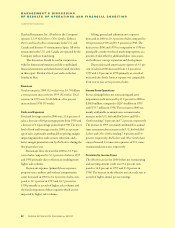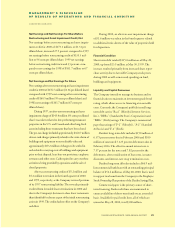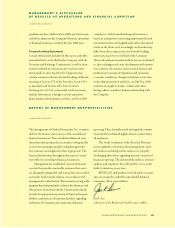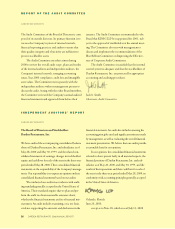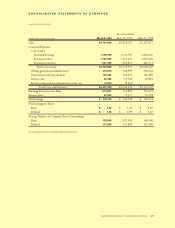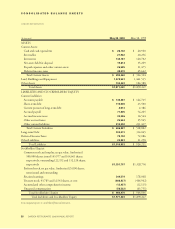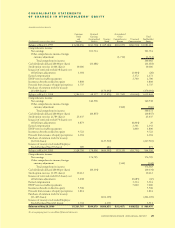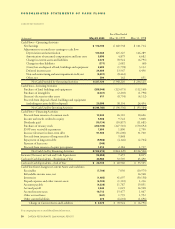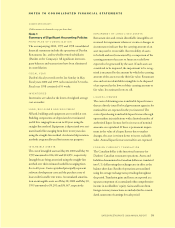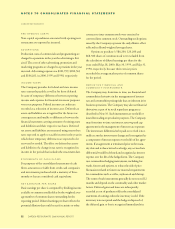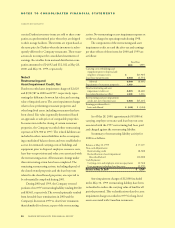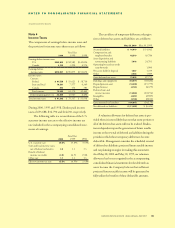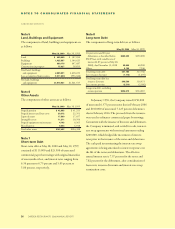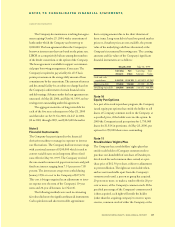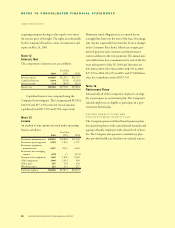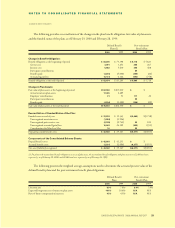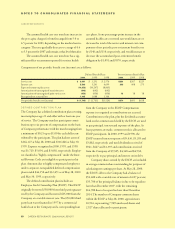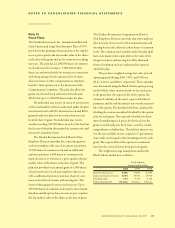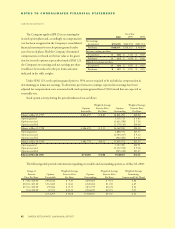Red Lobster 2000 Annual Report Download - page 35
Download and view the complete annual report
Please find page 35 of the 2000 Red Lobster annual report below. You can navigate through the pages in the report by either clicking on the pages listed below, or by using the keyword search tool below to find specific information within the annual report.
NOTES TO CONSOLIDATED FINANCIAL STATEMENTS
DARDEN RESTAURANTS
PRE-OPENING COSTS
Non-capital expenditures associated with opening new
restaurants are expensed as incurred.
ADVERTISING
Production costs of commercials and programming are
charged to operations in the year the advertising is first
aired. The costs of other advertising, promotion and
marketing programs are charged to operations in the year
incurred. Advertising expense was $181,959, $180,563
and $186,261, in 2000, 1999 and 1998, respectively.
INCOME TAXES
The Company provides for federal and state income
taxes currently payable as well as for those deferred
because of temporary differences between reporting
income and expenses for financial statement purposes
versus tax purposes. Federal income tax credits are
recorded as a reduction of income taxes. Deferred tax
assets and liabilities are recognized for the future tax
consequences attributable to differences between the
financial statement carrying amounts of existing assets
and liabilities and their respective tax bases. Deferred
tax assets and liabilities are measured using enacted tax
rates expected to apply to taxable income in the years in
which those temporary differences are expected to be
recovered or settled. The effect on deferred tax assets
and liabilities of a change in tax rates is recognized in
income in the period that includes the enactment date.
STATEMENTS OF CASH FLOWS
For purposes of the consolidated statements of cash
flows, amounts receivable from credit card companies
and investments purchased with a maturity of three
months or less are considered cash equivalents.
NET EARNINGS PER SHARE
Basic earnings per share is computed by dividing income
available to common stockholders by the weighted aver-
age number of common shares outstanding for the
reporting period. Diluted earnings per share reflects the
potential dilution that could occur if securities or other
contracts to issue common stock were exercised or
converted into common stock. Outstanding stock options
issued by the Company represent the only dilutive effect
reflected in diluted weighted average shares.
Options to purchase 3,586,200, 120,200 and
868,300 shares of common stock were excluded from
the calculation of diluted earnings per share for the
years ended May 28, 2000, May 30, 1999, and May 31,
1998, respectively, because their exercise prices
exceeded the average market price of common shares
for the period.
DERIVATIVE FINANCIAL AND
COMMODITY INSTRUMENTS
The Company may, from time to time, use financial and
commodities derivatives in the management of interest
rate and commodities pricing risks that are inherent in its
business operations. The Company may also use financial
derivatives as part of its stock repurchase program as
described in Note 10. Such instruments are not held or
issued for trading or speculative purposes. The Company
may, from time to time, use interest rate swap and cap
agreements in the management of interest rate exposure.
The interest rate differential to be paid or received is nor-
mally accrued as interest rates change and is recognized as
a component of interest expense over the life of the agree-
ments. If an agreement is terminated prior to the matu-
rity date and is characterized as a hedge, any accrued rate
differential would be deferred and recognized as interest
expense over the life of the hedged item. The Company
uses commodities hedging instruments, including for-
wards, futures and options, to reduce the risk of price
fluctuations related to future raw materials requirements
for commodities such as coffee, soybean oil and shrimp.
The terms of such instruments generally do not exceed 12
months and depend on the commodity and other market
factors. Deferred gains and losses are subsequently
recorded as cost of products sold in the consolidated
statements of earnings when the inventory is sold. If the
inventory is not acquired and the hedge is disposed of,
the deferred gain or loss is recognized immediately in
32 DARDEN RESTAURANTS 2000 ANNUAL REPORT


